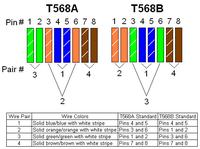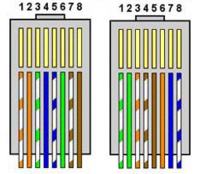Hello.
There are 2 types of twisted pair in the network. In one version, the brown and blue pairs do not move
1 -> 3, 2 -> 6
3 -> 1, 6 -> 2

in the second they are crossed
1 -> 3, 2 -> 6
3 -> 1, 6 -> 2
4 -> 7, 5 -> 8
7 -> 4, 8 -> 5

1. What is the difference between them? Do all devices support both variants (I checked on PS3 and work with both and with a straight cable)? When should this variant be used? Can they be recognized by some other marking, or only by the colors (or tester)?
2. Is the straight cable made according to T568A or T568B? I know it doesn't make much difference, but maybe some standards describe it? After all, arranging in any order but identical on both sides would also work, but that's not the point.
3. Patchcord is only a crossover cable (crossover) - following Wikipedia - or is each twisted pair (and not only) terminated with lugs?
Many questions and maybe not the most important ones, but recently I started to earn tips and I would like to know how it should be done.
There are 2 types of twisted pair in the network. In one version, the brown and blue pairs do not move
1 -> 3, 2 -> 6
3 -> 1, 6 -> 2

in the second they are crossed
1 -> 3, 2 -> 6
3 -> 1, 6 -> 2
4 -> 7, 5 -> 8
7 -> 4, 8 -> 5

1. What is the difference between them? Do all devices support both variants (I checked on PS3 and work with both and with a straight cable)? When should this variant be used? Can they be recognized by some other marking, or only by the colors (or tester)?
2. Is the straight cable made according to T568A or T568B? I know it doesn't make much difference, but maybe some standards describe it? After all, arranging in any order but identical on both sides would also work, but that's not the point.
3. Patchcord is only a crossover cable (crossover) - following Wikipedia - or is each twisted pair (and not only) terminated with lugs?
Many questions and maybe not the most important ones, but recently I started to earn tips and I would like to know how it should be done.



